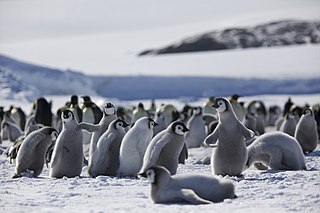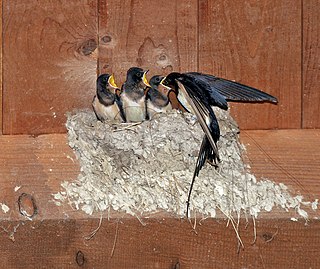Evolutionary theory
Conflict driving mate desertion
Mate desertion involves the decision by an already-mated individual to either continue providing parental care or to desert. [1] In making this decision, a parent must balance investment in terms of current and future reproductive success, choosing the optimal strategy, or one that provides the greatest net benefit towards lifetime reproductive success. Current success is measured by the number of surviving offspring, whereas future success is measured by the potential to successfully produce offspring in future seasons. [2] These trade-offs between costs and benefits are further reflected in the two major conflicts driving mate desertion: 1) parent-offspring conflict over the level of parental investment that a parent should provide and 2) sexual conflict between mates over who should provide care and how much care should be provided.
According to evolutionary biologist Robert Trivers, parental investment is defined as “any investment by the parent in an individual offspring that increases the offspring's chance of surviving (and hence reproductive success) at the cost of the parent's ability to invest in other offspring.” [2] This investment includes investing in gametes and feeding and protecting young, which is also known as brooding. Often, the amount of parental investment necessary to maximize fitness differs between parent and offspring, thereby creating parent-offspring conflict. While increasing parental investment increases the current offspring's likelihood to survive and reproduce, this investment comes at the expense of the parent's ability to invest in future offspring. Therefore, when uniparental care is equally effective as biparental care, natural selection will favor mate desertion, allowing the deserter to either remate or conserve resources for future reproduction.
However, the decision of which mate deserts first and when creates varying reproductive outcomes for both males and females, leading to sexual conflict over parental investment. This occurs because the deserted organism pays all costs of parental care while the deserter not only shares the benefits of the reproductive success of the current offspring, but also gains benefits from additional mating opportunities. [3] Theoretically, both males and females would be expected to evolve adaptations in response to this sexual conflict, which would ultimately lead to sexually antagonistic coevolution between male and female traits.

In penduline tits (Remiz pendulinus), uniparental care is dominant, and either sex is capable of desertion during the egg laying period. Typically, females care 50–70% of the time, males care 5–20% of the time, and both parents desert 30–40% of the time, condemning the offspring to death. [4] In this system, males build elaborate nests and usually desert once these nests have been filled with the females' eggs. [3]
As a result, in response, females have adopted two counter-adaptive behaviors that function to deceive the male regarding the clutch's progress. Females conceal their eggs by burying them and aggressively attack males who approach the nest during the egg laying period. Studies have shown a high correlation between length of time a male stays before deserting and number of days a female keeps her eggs buried. [5] This relationship suggests that egg burial has evolved as an adaptive female behavior that attempts to control information males use to decide whether or not they should desert.
Response to desertion
After one partner deserts, the remaining partner has three options. First, it may attempt to raise the young on its own. This usually occurs when the investment required by one parent to successfully raise the current offspring to maturity is less than that needed to produce new offspring. As a result, the remaining partner is forced into a situation Trivers' coined as “cruel bind.” [6] Here, the deserter effectively forces its partner to stay, gaining the benefit of the deserted parent's continued investment at the cost of additional mating opportunities for the deserted parent.
Second, if the cost of raising offspring alone is high and the cost of remating is low, the deserted individual may choose to desert the offspring as well and attempt to breed again. [2] In some cases, the second deserter may even take part in filial cannibalism, reaping its lost investment by eating its own offspring as nourishment. For example, in scissortail sergeant fish (Abudefduf sexfasciatus), male parental care is dominant, and males undergo brood cycling in which they alternate between mating and parental phases. When broods are artificially reduced early in the breeding phase, male scissor-tail sergeants are more likely to cannibalise eggs and return to the mating phase, primarily because reduced broods indicate decreased current reproductive success. [7]
Lastly, a deserted individual may also attempt to trick another mate into helping provide care for its young, circumventing its cruel bind. [2] For instance, a female who cuckolds a male, deceiving him into raising another male's offspring, benefits by reducing the amount of care she must provide and by conserving resources for future reproduction. In response, the evolution of counter-adaptations that allow males to guard against female deception would be expected, as it is evolutionarily maladaptive for an organism to invest in unrelated offspring. [2]
















